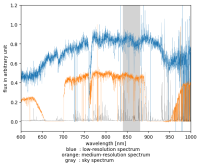-
Type:
Task
-
Status: Done (View Workflow)
-
Priority:
Normal
-
Resolution: Done
-
Affects Version/s: None
-
Fix Version/s: None
-
Component/s: None
-
Labels:
-
Epic Link:
Some of the FLUXSTDs have very low S/N and they are useless. Let's implement a S/N cut for FLUXSTDs to use in fluxCal.
